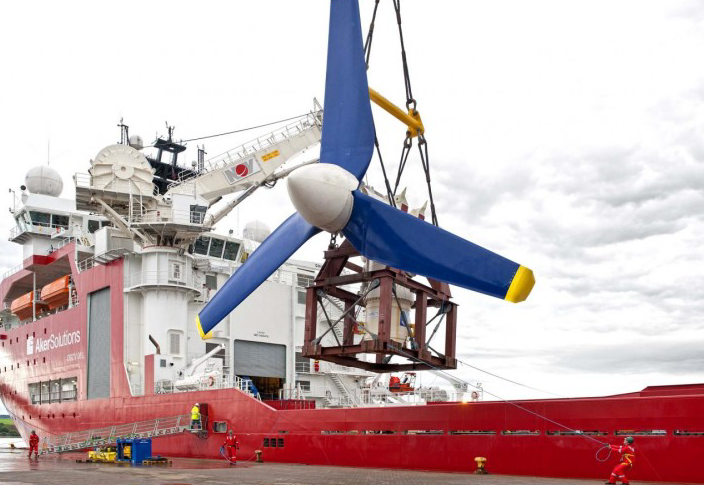Over the past 500 years, approximately 500 land-based animal species have gone the way of the dodo, becoming extinct as a result of human activity. In the ocean, where scientists count only 15 or so such losses, the numbers currently aren't nearly as dire. But that doesn't mean they aren't yet heading in that direction.
A consortium of scientists, including UC Santa Barbara's Douglas McCauley, has found that the same patterns that led to the collapse of wildlife populations on land are now occurring in the sea. According to the researchers, wildlife populations in the oceans are as healthy as those on land were hundreds or thousands of years ago. However, they warn, that may be about to change as the next 100 years promise to present major challenges to marine life. Their findings are published in the journal Science.

Tidal turbines such as the one pictured here will be used to convert the energy of the tides into useful forms of power, mainly electricity.
The new paper compares the march of the Industrial Revolution on land to current patterns of human use of the world's oceans. During the 1800s vast tracts of farmland and factories beat back forests and sucked up resources that were mined and drilled out of the ground. As a result, many terrestrial species were driven to extinction. In the ocean, however, fishing continued to rely on sailing ships clustered in small slivers of near-shore water.
"A lot has changed in the last 200 years," said lead author McCauley, a professor in UCSB's Department of Ecology, Evolution and Marine Biology (EEMB). "Our tackle box has industrialized."
Co-author Steve Palumbi of Stanford University lists several emerging threats to the oceans. "There are factory farms in the sea and cattle-ranch-style feed lots for tuna," he noted. "Shrimp farms are eating up mangroves with an appetite akin to that of terrestrial farming, which consumed native prairies and forest. Stakes for seafloor mining claims are being pursued with gold-rush-like fervor, and 300-ton ocean mining machines and 750-foot fishing boats are now rolling off the assembly line to do this work."
According to the authors, increasing industrial use of the oceans and the globalization of ocean exploitation threaten to damage the health of marine wildlife populations, making the situation in the oceans as grim as that on land. As McCauley pointed out, we now fish with helicopters, satellite-guided super trawlers and long lines that can stretch from New York to Philadelphia.
"All signs indicate that we may be initiating a marine industrial revolution," he said. "We are setting ourselves up in the oceans to replay the process of wildlife Armageddon that we engineered on land."
One solution the paper highlighted involves setting aside more and larger areas of the ocean that are safe from industrial development and fishing. However, co-author Robert Warner, an EEMB research professor at UCSB, cautioned that reserves alone are not enough. "We need creative and effective policy to manage damage inflicted upon ocean wildlife in the vast spaces between marine protected areas," he said.
Among the most serious threats to ocean wildlife is climate change, which according to the scientists is degrading marine wildlife habitats and has a greater impact on these animals than it does on terrestrial fauna. "Anyone that has ever kept a fish tank knows that if you crank up your aquarium heater and dump acid into the water, your fish are in trouble," said co-author Malin Pinsky, an ecologist at Rutgers University. "This is what climate change is doing now to the oceans."
Still, as the researchers emphasized, the relative health of the oceans presents an opportunity for saving them. "Because there have been so many fewer extinctions in the oceans, we still have the raw ingredients needed for recovery," said McCauley. "There is hope for marine species that simply does not exist for the hundreds of terrestrial wildlife species that have already crossed the extinction threshold."
The ocean's future is yet to be determined, the researchers said. "We can blunder forward and make the same mistakes in the sea that we made on land, or we can collectively chart a different and better future for our oceans," Warner concluded.
Story Source:
The above story is based on materials provided by University of California - Santa Barbara. The original article was written by Julie Cohen. Note: Materials may be edited for content and length.
Journal Reference:
- D. J. McCauley, M. L. Pinsky, S. R. Palumbi, J. A. Estes, F. H. Joyce, R. R. Warner. Marine defaunation: Animal loss in the global ocean. Science, 2015; 347 (6219): 1255641 DOI: 10.1126/science.1255641

